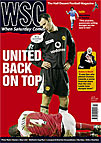 With Arsenal's decision to go a deeper shade of red, Steve D Wilson looks at the stories behind commemorative kits
With Arsenal's decision to go a deeper shade of red, Steve D Wilson looks at the stories behind commemorative kits
At first glance Arsenal’s decision to wear a dark red home shirt in 2005-06 marks a pleasant change in modern football attitudes. The club will wear the new kit for one year to commemorate their final season at Highbury – it is the colour they originally wore when they moved to the north London stadium from Woolwich in 1913.
After the bad press Arsenal received over calling their new ground the Emirates Stadium to tie in with a £100 million sponsorship deal, this move seems to show the club going out of their way to respect the memories built up at their current home. Although cynics might say it will also mean fans have three new home shirts to buy between 2004 and 2006.
The origins of Arsenal’s colours go back to their early days as the Royal Arsenal workers’ team. Fred Beardsley and Morris Bates had moved to Woolwich in search of employment and when the works side were short of a kit they wrote to their former club Nottingham Forest, who supplied them with the red shirts and white shorts. The look was deemed so good by Sparta Prague that they adopted the colours for their strip in 1906.
The white sleeves weren’t introduced until 1933, thanks to the pioneering Herbert Chapman. Many stories circulate as to why, but the generally accepted reason is that he had seen someone wearing a red sleeveless pullover over a white shirt. The club dabbled again with an all-red shirt in the early 1960s, but it was not a popular change and lasted only a season.
The official line on the decision from Arsenal saw Arsène Wenger saying it was a way of “encapsulating more than 90 years of memories”. Patrick Vieira also offered an opinion, calling the kit “special” and “a really nice touch”. Fans’ reactions were not all complimentary. The majority on Arsenal message boards spoke through evidently gritted teeth about how it was all about tradition and that it’s who is in the shirt that matters. The vocal dissenters revealed the concerns – fear of ridicule from rivals, a feeling the club was going down the Manchester United route of shirt turnover and that the underlying motive for the change was to rake in more money from the loyal supporters.
The revenue available from shirt sales is well documented and Arsenal wouldn’t be the first to cash in with a special shirt. Charlton Athletic’s centenary strip was the fastest-selling kit the club has had even though it was only used in one league match, friendlies and an FA Cup tie. Even Barcelona, whose shirt is so sacred it is yet to be sullied with a sponsor’s logo, switched from red-and-blue stripes in 1999 to red-and-blue halves to mark their centenary.
Several sides over the years have opted to revive their original colours through their away kit, notably Manchester United’s green-and-yellow shirt in the early 1990s and Juventus’s fetching pink number to celebrate their centenary. It is hard, though, to think of an occasion when a club has made such a noticeable change to their home kit for a whole season for such an unusual reason as moving stadium.
Surely the most obvious way of respecting tradition without appearing to milk the fans for more money, and without taking the drastic step of changing the current distinctive Arsenal colours for a whole season, would have been to just wear a special dark red shirt for the final ever league game at Highbury? And why not employ one other innovation all Arsenal fans would surely get behind – charge 1913 prices.
From WSC 217 March 2005. What was happening this month